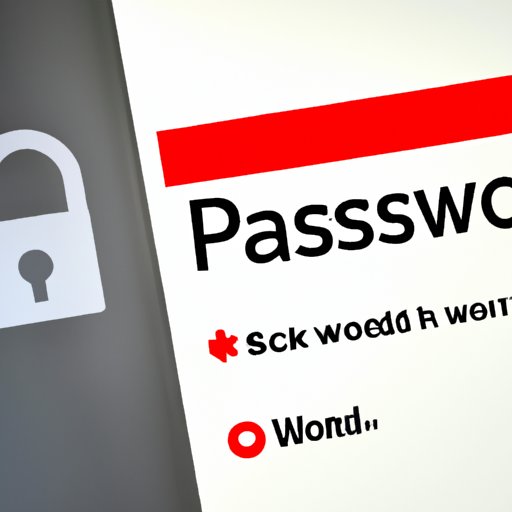
Introduction
Gmail is one of the world’s most popular email services, consistently ranking high in user satisfaction. However, with the increasing number of hacking and security breaches, the need to change your password frequently is imperative. Changing your Gmail password provides an extra layer of security, keeping your important emails, files, and sensitive information well-protected.
In this article, we’ll show you how to change your Gmail password step-by-step and provide tips on password security and maintenance.
Step-by-step guide
Changing your Gmail password is easy, as long as you follow the instructions carefully.
First, log into your Gmail account.
Next, follow these steps:
- Click on the gear icon in the top-right corner of your Gmail inbox.
- Select “Settings” from the dropdown menu.
- Click on the “Accounts and Import” tab.
- Scroll down to the “Change account settings” section and click on the “Change password” link.
- Enter your current password and then your new desired password. Make sure it is strong and not an easy guess for hackers.
- Click on “Change Password” to complete the process.
It’s important that you follow the steps in order, or else you might face some issues in changing your password. Also, we recommend you to choose a strong password that consists of a combination of letters, numbers, and special characters.
Video tutorial
We’ve included a video below that demonstrates how to change your Gmail password for those who are visual learners. Watch this video to help you better understand the process:
Along with these instructions, this video also includes several additional tips and information that help you stay safe and secure while changing your password.
Common mistakes
When changing your Gmail password, there are a few common mistakes that people often make:
- Using the same password across multiple accounts
- Using dictionary words as passwords
- Choosing a password that is too easy to guess
These mistakes can lead to security vulnerabilities and make your account more susceptible to hacking. To avoid these mistakes, we suggest you choose a strong and complex password that is not easy to guess. Also, avoid using the same password across multiple accounts.
We also recommend you log out of all your devices and check for any suspicious activity on your account. If you notice any malicious activity, we suggest that you change your password immediately and enable 2FA, which we will discuss in the next section.
Security measures
Using a strong password and changing it regularly is one of the most effective ways to protect your Gmail account from hacking and security breaches. To create a strong password, we suggest you:
- Use a combination of letters, numbers, and special characters
- Use a password manager to help you avoid reusing passwords across multiple accounts
- Avoid using dictionary words as passwords
Password managers can help you create and securely store complex passwords without forgetting them. However, when using a password manager, make sure you choose a reliable one.
Alternative ways
In addition to changing your Gmail password directly through Google, there are other alternative ways to change your password. These include using third-party apps that can help you manage your passwords efficiently.
However, these methods can pose some security risks. It’s best to change your password directly through Google to ensure maximum security. These methods should always be viewed with caution and chosen carefully only after thorough research.
Two-factor authentication (2FA)
Two-factor authentication is an additional layer of security applied to your Gmail account. It makes sure that anyone trying to log in must be authorized through another device or application, such as an app or text-based verification code, that you have access to.
It’s simple to enable 2FA for your Gmail account:
- Log in to your Gmail account.
- Select your profile picture and click on “Google Account”
- Select “Security” from the left-side menu and scroll to “2-Step Verification”.
- Select “Get started”.
- Follow the instructions provided on your screen.
It’s important that you have access to the other devices or applications that you choose to use for verification. If you lose or change these, make sure to update your security settings accordingly.
Importance of changing passwords regularly
Changing your password regularly is critical for maintaining account security. Passwords do not last forever and need to be updated to keep hackers at bay. The recommended password change time limit is around 90 days.
If you do not update your password regularly, your account can become more vulnerable to hacking and security breaches. Unfortunately, if you’re hacked, it can lead to identity theft, credit card fraud, and other devastating online crimes. Therefore, it’s important to maintain your passwords frequently.
Other tips and tricks for password hygiene include:
- Enable password-protected screen savers
- Avoid memorizing your password by writing it on paper or keeping it hidden online.
- Avoid clicking on suspicious links
- Avoid disclosing your password to anyone, especially strangers
Conclusion
Changing your Gmail password is easy and one of the most important steps you can take to maintain account security. We hope this article has helped you understand how you can change your Gmail password step-by-step. Remember to choose a strong password, avoid common password mistakes, and enable 2FA to help you protect your account from unwanted access. Stay safe and always keep your password updated frequently.
If you’re interested in learning more about keeping your Gmail account secure, check out further resources online.




